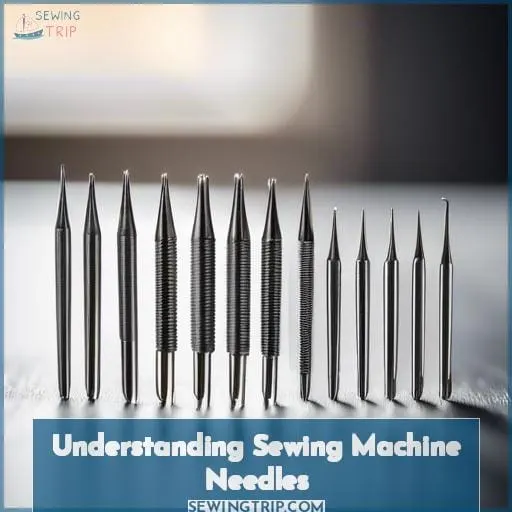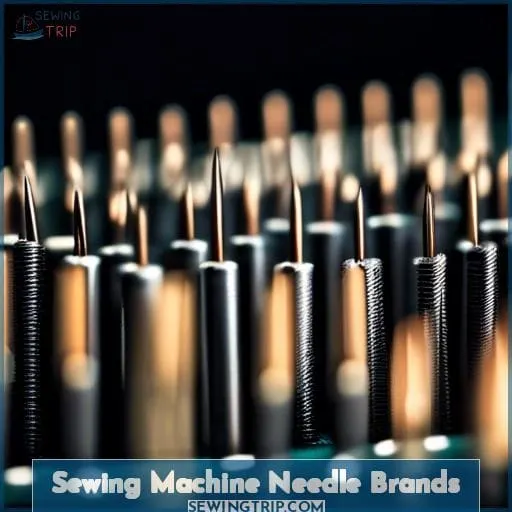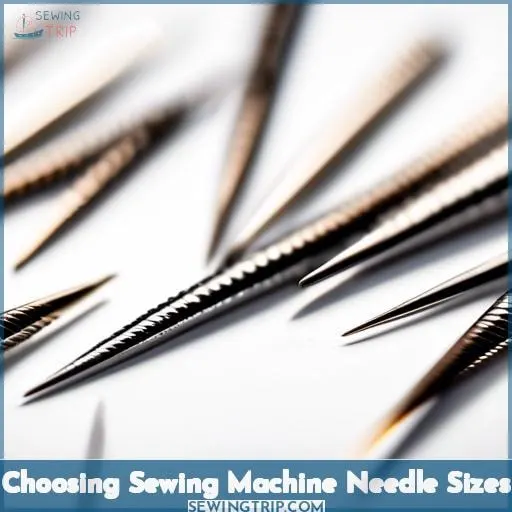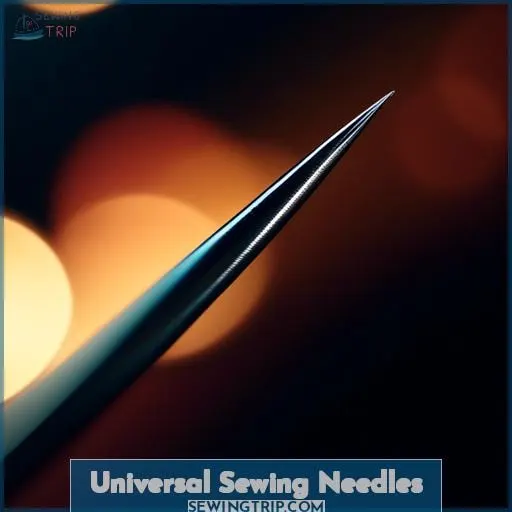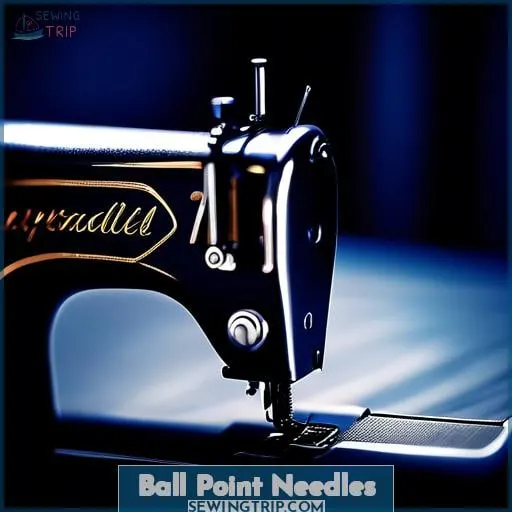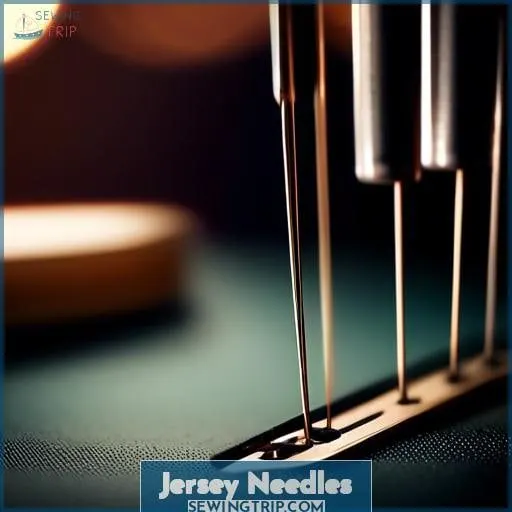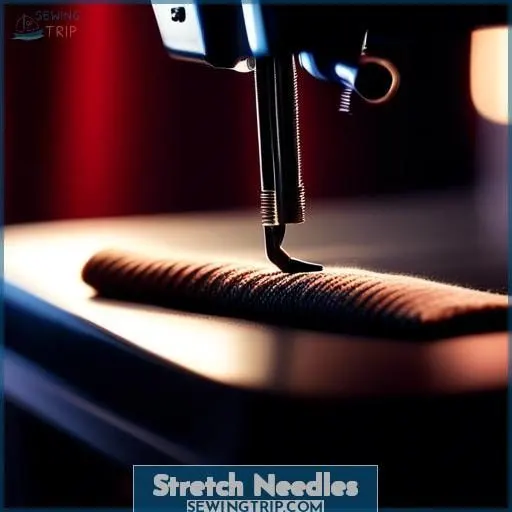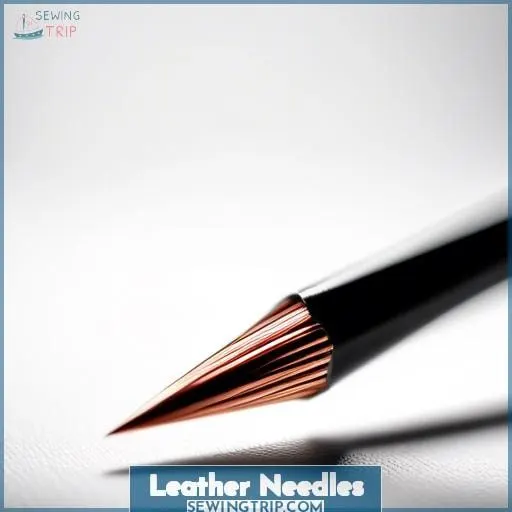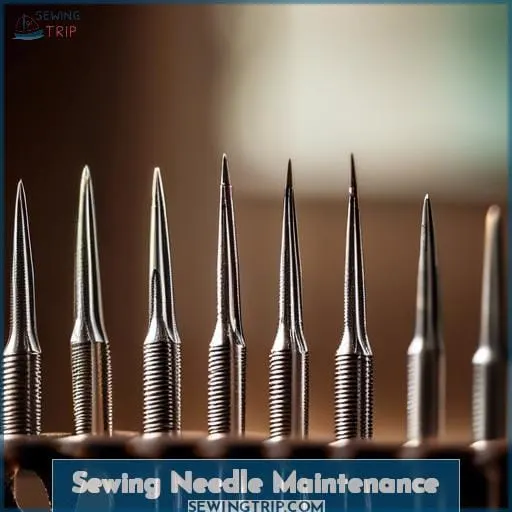This site is supported by our readers. We may earn a commission, at no cost to you, if you purchase through links.
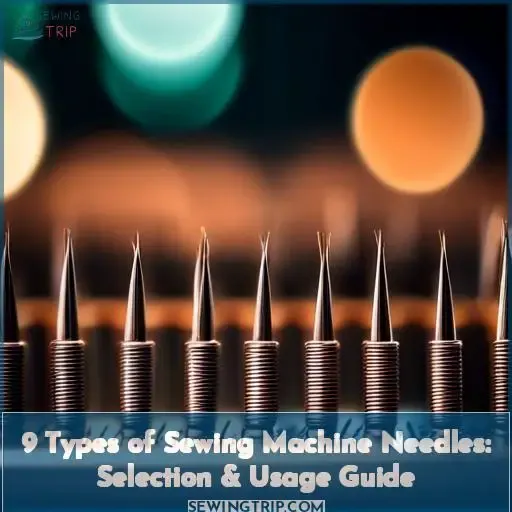
You’re about to master the art of selecting the perfect needle for any fabric or project.
Our guide on the 9 types of sewing machine needles and their uses will ensure your stitches are impeccable, whether you’re working with delicate silks or tough leathers.
Dive into the specifics and elevate your sewing game with our expert insights on needle selection and usage.
Table Of Contents
Key Takeaways
- Needle Selection is Crucial: Selecting the right needle for your fabric and project is essential, as 80% of sewing machine problems are related to the needle. It’s important to match the needle size to the fabric weight and thread thickness for optimal results.
- Types of Needles for Specific Fabrics: There are specialized needles for different types of fabrics – Universal needles for most fabrics, Ballpoint needles for knits, Stretch needles for elastic materials, Leather needles for tough projects, and Jersey needles for soft, stretchy fabrics.
- Needle Maintenance and Replacement: Needles should be replaced every 6 to 8 hours of sewing to maintain the quality of your work. Proper insertion and tightening of the needle are crucial to avoid breakage.
- Considerations for Needle Brands and Recycling: Quality brands like Klasse, Singer, and Schmetz offer durable needles with a wide range of types and sizes. While sewing machine needles can be recycled, it’s important to be aware of potential allergic reactions to metals and the fact that there are no biodegradable options available.
Understanding Sewing Machine Needles
Diving into the world of sewing machine needles, think of yourself as an explorer in a vast landscape of creativity. Each needle, from its material to its size, plays a pivotal role in your sewing journey.
Imagine needle types as your trusty companions, guiding your fabric through every stitch with precision. Remember, a well-organized needle storage is like a treasure chest, keeping your tools sharp and ready.
Speaking of sharp, forget about needle sharpening; focus on timely needle replacement to keep your projects running smoothly. Safety is key, so handle your sewing needles with care, avoiding any unexpected pricks.
This needle guide is your map, leading you through the diverse terrain of needle sizes and types, ensuring your sewing machine is always equipped for adventure.
Sewing Machine Needle Brands
When selecting sewing machine needles, it’s essential to choose the right brand for your project. Klasse, Singer, and Schmetz are three reputable brands that offer a range of needles for various fabric types and sewing applications.
Each brand provides needles with specific features. Klasse offers a color-coded system for easy identification, while Schmetz has a wide selection for high-quality, smooth stitches.
Whether you’re working with delicate fabrics or heavy materials, these brands have options to ensure your sewing is successful and enjoyable.
Klasse Needles
Klasse needles, a staple in the sewing world, undergo a rigorous 155 quality checks, ensuring they meet the highest standards for stability, seam appearance, and stitch precision.
Each needle is uniquely numbered for easy identification, catering to a wide range of sewing needs, from universal to specialized types like leather and quilting.
Their compatibility with most modern sewing machines and the variety offered make Klasse needles a go-to choice for sewers seeking quality and durability.
Whether you’re a beginner or a seasoned pro, Klasse needles provide the reliability and performance needed for your sewing projects.
Singer Needles
After diving into Klasse needles, let’s thread our way to Singer needles. These stalwarts in the sewing game offer:
- A variety of Singer models to fit your machine like a glove.
- Needle storage solutions that keep point sharpness on point.
- Fewer compatibility issues, ensuring a smooth sewing experience.
- Competitive price comparisons, making them a savvy choice for needle selection and usage.
Schmetz Needles
Dive into the world of Schmetz needles, your go-to for durability and sharpness. With Schmetz, you’re equipped for any fabric adventure, thanks to their wide range of types and sizes.
| Schmetz Needle Types | Uses |
|---|---|
| Universal | Versatile for most fabrics |
| Ballpoint | Knits without snagging |
| Stretch | Elastic materials like spandex |
| Leather | Tough, for leather projects |
| Jersey | Soft, stretchy fabrics |
Choosing Sewing Machine Needle Sizes
When selecting sewing machine needle sizes, it’s crucial to match the needle to your fabric’s weight and the thread you’ll be using. The right needle size ensures smooth sewing and protects your fabric from damage.
For instance, finer needles are best for lightweight fabrics, while thicker needles can handle heavy materials like denim or canvas. It’s also important to insert the needle at the correct angle to avoid breakage and ensure proper stitch formation.
Fabric Weight Compatibility
When you’re matching needle to fabric, think of it as setting up a blind date between two very particular personalities.
You want harmony, not a clash.
So, for those gossamer-thin fabrics, a fine needle gauge like 60/8 will do the trick, gliding through without a snag.
But when you’re dealing with the tough guys, like denim or canvas, you’ll want a jeans needle that’s built like a linebacker, strong and sharp, to tackle those heavy weaves without breaking a sweat.
Needle Thickness Importance
Choosing the right needle gauge is like picking the perfect arrow for your sewing quiver.
Thicker needles tackle the tough hide of denim, while their slender cousins glide through silk like a hot knife through butter.
Check out a sewing needle guide for a bullseye match every time.
Thread and Needle Harmony
Finding the perfect match between thread and needle is like hitting the bullseye in darts—it’s a game-changer.
- Match needle materials to thread type for smooth sewing.
- Choose needle shapes that complement your fabric’s character.
- Ensure needle compatibility with your machine for peak performance.
- Pick the right needle gauge options for your thread weight.
Correct Angle Insertion
When inserting your needle, think of it as a precision dance move: the angle’s got to be spot on.
A misstep here and you’re jamming instead of gliding. Keep it sharp, folks—dull needles are no-no’s in the fabric boogie.
Slide that needle home with care, store it smart, and keep your needle groove smooth with regular maintenance.
Universal Sewing Needles
Shifting gears from the nitty-gritty of needle sizes, let’s dive into the jack-of-all-trades in the sewing kit: universal needles.
These trusty tools are the Swiss Army knives of the sewing world, ready to tackle a broad spectrum of fabrics with aplomb. Whether you’re stitching up a storm on denim or delicately darning silk, universal needle types stand ready to serve.
Their widespread availability and compatibility with nearly all sewing machines make them a go-to for sewers of every stripe. From beginners to seasoned pros, the universal needle ensures your project doesn’t come to a prickly halt.
With a lifespan that balances durability with the need for occasional replacement, these needles ensure your sewing adventure is smooth sailing. Keep this sewing needle guide handy for all levels, fabrics, projects, and machines, ensuring you’re always prepared, no matter the sewing challenge ahead.
Ball Point Needles
After covering the versatility of universal sewing needles, let’s dive into the world of ball point needles.
Unlike their sharper counterparts, ball point needles have a blunt tip, making them perfect for sliding between fabric yarns without snagging. Imagine them as polite guests at a party, mingling through the crowd without causing a ruckus.
This blunt tip application shines when handling fabrics with elasticity, ensuring your stitches are secure without damaging those delicate materials.
Whether you’re working on a cozy sweater or a stretchy yoga pant, selecting the right ball point needle can make all the difference, turning potential sewing frustrations into a smooth sailing project.
Remember, not all needles are created equal—choosing the right one is key to fabric harmony.
Jersey Needles
After diving into the world of ballpoint needles, let’s shift gears to Jersey needles, your go-to for medium-stretch knit fabrics. These needles are a game-changer for anyone passionate about creating with Jersey fabric.
- Jersey Fabric Compatibility: They slide between fibers like a hot knife through butter, preventing snags and ensuring smooth stitches.
- Jersey Needle Sizes: Available in a variety of sizes, they cater to different thread weights and fabric thicknesses, making your sewing project as easy as pie.
- Jersey Needle Care: Like caring for a prized possession, regular checks and replacements keep your stitches flawless.
Stretch Needles
When you’re diving into the stretchy depths of spandex or swimwear, you’ll want your trusty stretch needles by your side. These little heroes are designed with needle sharpness that pierces through the most rebellious of fabrics without causing a snag.
Imagine them as your fabric whisperers, turning potential sewing nightmares into a dream.
| Feature | Why It Matters |
|---|---|
| Needle Sharpness | Cuts through stretch fabrics easily |
| Needle Durability | Handles the stretch without breaking |
| Needle Safety | Reduces risk of mishaps |
| Needle Ergonomics | Comfort in every stitch |
| Needle Storage | Keeps your tools organized and safe |
Leather Needles
After stretching your skills with stretch needles, let’s dive into the tough world of leather needles.
Picture this: you’re about to tackle a project that’s as stubborn as an old mule, and that’s where leather needles come into play. These needles are the cowboys of the sewing needle family, designed with a specific needle point to pierce through tough materials without breaking a sweat.
When selecting your needle, remember that needle gauges and needle tips are your roadmap to success. Keep your needles organized like a treasure chest—needle storage is key to keeping your arsenal ready.
For those looking to master the art of sewing, understanding the 9 types of sewing machine needles and their uses is crucial. This sewing needle guide for advanced users will ensure you’re not just sewing, but crafting stories with every stitch.
Sewing Needle Maintenance
Maintaining your sewing machine needles is crucial for ensuring smooth sewing experiences and high-quality results. Remember, it’s time to change your needle every 6 to 8 hours of sewing to prevent issues like thread breakage or skipped stitches.
When inserting a new needle, make sure the flat side faces the back of the machine and tighten the screw securely to avoid the needle dropping out while sewing.
How Long Do Needles Last?
When transitioning from the tough world of leather sewing to the delicate art of needle maintenance, it’s like swapping a leather jacket for a lab coat.
Just as you wouldn’t use a sledgehammer to crack a nut, the same precision is required when caring for your sewing needles. Think of needle care as the secret sauce to flawless sewing; it’s all about keeping them sharp, clean, and well-organized.
Imagine your needle as a trusty steed in a knight’s arsenal—it needs regular care to stay in tip-top shape. Needle lifespan is a dance with fabric and thread; they don’t last forever, but with a bit of TLC, including proper storage and timely disposal, they’ll serve you well.
How to Insert a Needle
When it’s time to swap out that trusty needle, remember it’s not just a chore, it’s a fresh start for your sewing machine!
First, power down your machine to avoid any oops moments. Loosen the needle clamp screw—lefty loosey, righty tighty—and gently remove the old needle.
Now, grab your shiny new needle and let’s get down to business. Make sure the flat side is giving the back of your machine the cold shoulder, and slide the needle up as high as it can cozy up.
Tighten that screw with gusto, ensuring the needle won’t wiggle out of place and throw a wrench in your sewing groove.
Keep that needle sharp, clean, and stored properly to avoid any prickly situations.
Frequently Asked Questions (FAQs)
Can sewing machine needles be recycled?
Sewing machine needles can indeed be recycled, but it’s not as straightforward as tossing them into your recycling bin.
Consider using an old prescription bottle or a similar container as a DIY sharps bin. Once it’s full, seal it up tight and then chuck it in the trash. This method keeps everyone safe—no nasty surprises for sanitation workers or anyone else.
So, while you can’t directly recycle them with your cans and bottles, you’re still doing your bit for the planet and safety!
How does humidity affect sewing needle longevity?
Like a ship navigating through the unpredictable sea, your sewing needles face the ebb and flow of humidity. High humidity acts as a silent siren, luring the steel to a premature rust, while dry conditions keep them sailing smoothly.
Are there biodegradable sewing machine needles available?
Currently, there aren’t biodegradable sewing machine needles available on the market.
The focus has been on reducing plastic in packaging, like Organ’s eco-packs, but the needles themselves are metal and not biodegradable.
Can sewing machine needles cause allergic reactions?
Yes, sewing machine needles can cause allergic reactions, especially if you’re sensitive to metals like nickel, which is often used in needle manufacturing.
If you’re breaking out in hives or itching like there’s no tomorrow, it might be your needles giving you grief, not just the frustration of a botched seam.
Do sewing machine needles have an expiration date?
Sewing machine needles don’t have an expiration date per se, but they’re like Cinderella’s carriage at midnight. They don’t turn into pumpkins, but they might as well, given how they can go from sharp to dull faster than you can say bobbin if not replaced regularly.
Conclusion
Just as a painter selects the perfect brush for each stroke, your journey through the 9 types of sewing machine needles equips you with the tools to bring your fabric masterpieces to life.
With this guide, you’re set to make informed choices, ensuring your stitches are flawless, whether on silk or leather.

